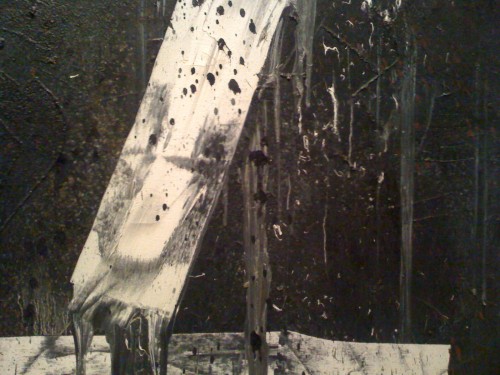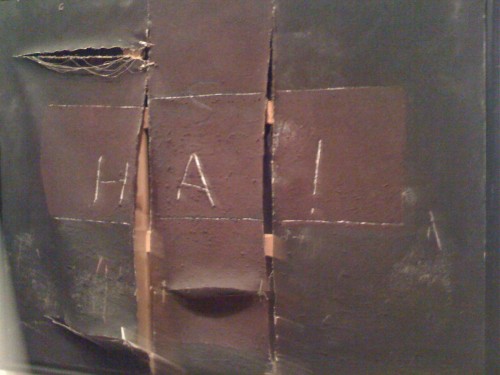Roger Conner Jr
Leaving Frankfort I drove to Lexington, and after an overnight stay in a hotel went to the University of Kentucky art museum, where an excellent exhibition of Ancient Egyptian artifacts called “Excavating Egypt”is on display. This exhibit permitted no photography, and while it may have been possible to sneak a non-flash picture on my cell phone, respect mitigated against it. I was in the presence of a form of holiness: The bond of culture to culture, human to human was being respected.
http://www.uky.edu/ArtMuseum/Excavating_Egypt.htm
http://www.uky.edu/ArtMuseum/welcome.html
How like us were these ancient sophisticates of 3000 and more years ago, with their cosmetics and make up bowls, decorated pottery and beads, necklaces and vanity pieces of jewelry!
Thoughts of the temporality of beauty and prosperity and of the fleeting presence of friends and lovers were gathering around me again.
Can art, craft and literature act as the sword and armor in the battle against the forces of time? Perhaps not, but they are all we have in our quest to keep the flame of our ideas, feelings and passions alive from one age to the next. The colums of the Greeks survive in central Kentucky even when they may be endangered in Athens, the artifacts of the Ancient Egyptians are displayed in a small Kentucky University Museum, the delicate craft art of Chinese bottles are in a small booth at a country craft fair.
Some may complain that there are too many artists, too many books, they cannot all be seen and read! But the case can be made for intellectual and cultural redundancy, for repeating a thousand or a million themes and metaphors a thousand or a million ways.
No matter how many times art and beauty are repeated, the forces of annihilation will be repeated at least as often.
The human spirit is in a race to conserve itself and the higher aspirations of humanity, to preserve and improve the work of our creative brothers and sisters in culture. The battle is never ending. Soon it will be the battle our children will take up, and after them, their children.
I walked the small second floor of the University of Kentucky art gallery, and while looking at the works I also listened and watched the small number of other patrons examining the art works on display, commenting to friends or family they were in company with. I watched their eyes, noticed the pieces they were drawn to.
Simple works of beauty, landscapes and beautiful portraits of beautiful women still hold great appeal to many people, while the abstract modern pieces still confuse many. The abstract expressionism of the last half century may be accepted by the academies and the grant review committees, but are the misshapen and awkward stepchildren of art in the eyes of many museum patrons.
It was among these misshapen stepchildren that I found my two favorites in the UK museum, paintings that drove home to me the pain of our culture, the bane of all cultures. These paintings depicting the artistic activity of the struggle against destruction, annihilation, nihilism and anarchy, and finally sneering defiantly against the forces which would reduce us to the status of brutes and beasts were surprising finds in such a small gallery, such an unlikely place.
The 1961 painting by Michael Goldberg entitled “One Year Tim” below captures a sight seen all too often in the 20th century, the sight of debris, of dislocated and hanging material, the remnants of destruction, of a culture oozing and running, and hanging on by a shred. Even the word “time” in the title is damaged, as if time itself is nothing but debris.

How can hope in the cultural exercise by maintained after a century of wars of epic destruction of whole continents, whole peoples and whole cultures? We are a post apocalyptic people now, having seen horrors manufactured and exported around the globe, we are aware of the possibility of holocaust in a way that no culture has ever been, and aware that we do not need the help of the supernatural or of cosmic forces to bring these horrors upon ourselves. Threaten us not with Armageddon and do not make us wait for it in our fast moving self serve world, we can create it for ourselves soon enough, thank you.
And yet…
In the small places of the world hope survives and culture lives on, from the Greek columns and echos of ancient temples reborn in old Capitols and city halls to the school children looking for the first time at Egyptian sculpture and artifacts and realizing there was a world of living, thinking and feeling humans long before they and their parents lived, and wanting to know more, to see more and to feel more.
From the remaining buildings of an earlier age to the museums large and small, from the craft fairs and shops of small towns and cities to the libraries and bookstores with the words and stories that span generations, from the kings and prophets of ancient Mesopotamia and the near east to the 21st century aspiring writer or poet who writes as a labor of love for some small press after getting off from work at a paying job, the “long conversation”of the cultural exercise continues, and sneers at the forces of annihilation.
In the University of Kentucky art museum, my other new discovery:

Spanish artist Antoni Ta’pies came of age when Franco was already practicing the tactics which would soon be used to decimate all of Europe. Painted in a time of economic, political and energy crisis in 1974 is the work above, a canvas ripped and torn with it’s supporting skeleton exposed, the injured crimson cross barely hanging on to the framing: Art, culture and faith gashed and injured again and again sustains the injuries and sneers in the face of destruction with the one white word etched into the surface of the painting, the title of the painting: “HA!”
Art and culture will not be destroyed, dismissed nor starved into submission so easily as the bullies, the butchers and the bankers often assume.











No comments so far ↓
Nobody has commented yet. Be the first!
Comment